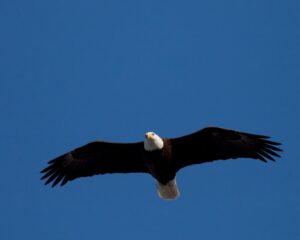Eagle Viewing Ethics
Human presence can stress the eagles and force them to use precious energy they need to survive. Being respectful, aware and cautious means we can continue to experience the joy and thrill we get from seeing eagles soar around the Fox River.
 Please give eagles space
Please give eagles space- Watch, but do not disturb
- Use binoculars or a zoom lens to get a closer look
- Do not use drones for photography
- Avoid loud noises, such as yelling, a car door slamming, a car horn honking and unnecessary movement
Facts About Bald Eagles
(Haliaeetus leucocephalus)
- Bald Eagles live an average of 20-25 years in the wild and approximately 40 years when cared for in a licensed center.
- Eagles are carnivores—they eat meat! Fish is their primary source of food.
- Eagles have two sets of eyelids and their eyes are eight times sharper than a human’s with 20/20 vision to spot a fish up to one mile away.
- The eagle’s beak is hooked and self-sharpening
- Eagles do not have sweat glands. To cool off they open their mouth and stick their tongue out.
- An eagle has 7,000 feathers and hollow bones
- Tail feathers can be tilted or spread to function as a rudder or brake
- An eagle’s 2″ long talons can exert 1,000 lbs. of pressure per square inch
- Bald Eagles have a “hallux” which is the largest and back talon on their foot.
- Eagles have special tendons in their legs that allow them to catch like a ratchet. The tendon can be relaxed to release the grip whenever necessary.
- Eagles can weight up to 15 lbs. and be 3 ft. tall with a wingspan of 6 ft.
- Eagles can fly up to 30/40 mph and can have a diving speed of 100 mph
- Eagles can swim—using their wings as oars.
- Bald eagles can mate exclusively throughout their lives, but it is not the rule. Bald eagles always go through the courtship rituals at the start of each nesting season.
- Eaglets within an egg will grow an “egg tooth” on the top of their beak, and a special “hatching muscle” swells in their neck. These natural tools allow them to break through the membrane of the egg and the egg itself.
- At just 10 – 14 weeks, eaglets will take their first flight. They might stick around the nest territory an additional 4 – 5 weeks to build up strength while the parents still provide food and watch over them.
- Bald Eagle live a solitary life when not in mating and nesting season. They do not go back to the nest to sleep or huddle up in groups.
- Eagles will move into an area with suitable habitat of water sources with plenty of food and tall trees for nesting and perching.
- Eagles spend about 98% of their time roosting/perching
Bald Eagle Protection and Threats
In the 1950’s a chemical known as DDT (dichlorodiphenyltrichloroethane) was introduced as a widespread insecticide. In 1962 a biologist documented the impact of spraying DDT and other chemicals on birds. Additional research showed that DDT, interfered with the calcium processing of birds resulting in deformed eggshells. Bald eagles, who feed primarily on fish, often received concentrated doses of DDT. Because bald eagles breed only once per year, and have a low reproductive rate, the bald eagle population declined steeply throughout the 1960’s and 1970’s.
In 1972, DDT was banned in the United States and the bald eagle was put on the Endangered Species List. Habitat conservation and reintroduction efforts helped ensure the successful recovery of the bald eagle and it was removed from the Endangered Species List in 2007.
However, bald eagles remain protected under the Bald and Golden Eagle Protection Act and the Migratory Bird Treaty Act.
The Bald and Golden Eagle Act prohibits anyone from taking, possessing, or transporting a bald eagle or golden eagle, or the parts, nests, or eggs of such birds without prior authorization. This includes inactive nests as well as active nests. Take means to pursue, shoot, shoot at, poison, wound, kill, capture, trap, collect, destroy, molest, or disturb. Activities that directly or indirectly lead to take are prohibited without a permit.
There are a number of different types of permits available for authorizing take, possession, and transport of bald and golden eagles.
The greatest threats to wild eagle populations are human made. With no natural predators, interactions with humans are the most dangerous threat an eagle faces. Collisions with cars or electrical lines cause injury to many eagles. Still more dangerous is lead they may encounter in the environment as a result of human recreational activities like hunting and fishing.
Lead Poisoning
Lead is extremely dangerous for eagles because of their powerful digestive system. If an eagle ingests even a small amount of lead, powerful stomach acids will break down the lead releasing into the blood stream. Once in the blood stream lead damages the nervous system and organs leading to motor control problems and ultimately organ failure. The impact on the nervous system and motor control can also be the cause of other injuries an eagle might suffer such as collisions with cars or power lines. Even a tiny amount of lead is lethal to an eagle within days. To help protect eagles and other wildlife, consider switching to lead-free fishing tackle and ammunition.
